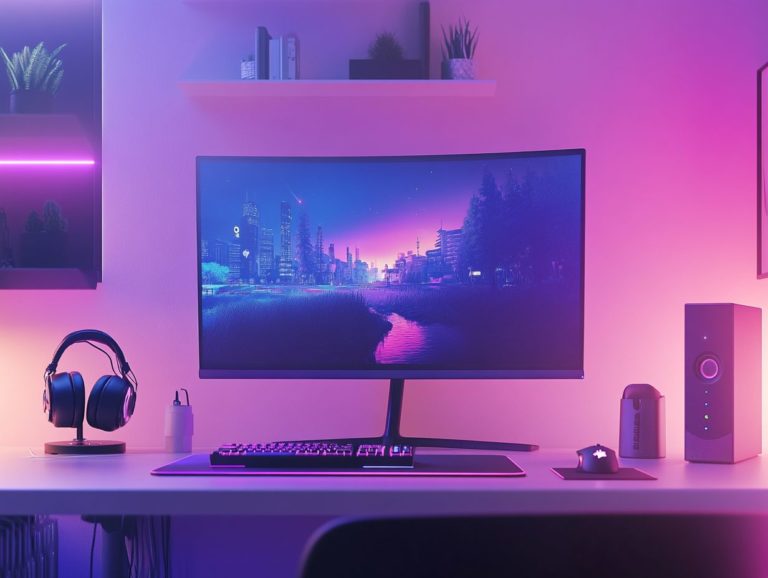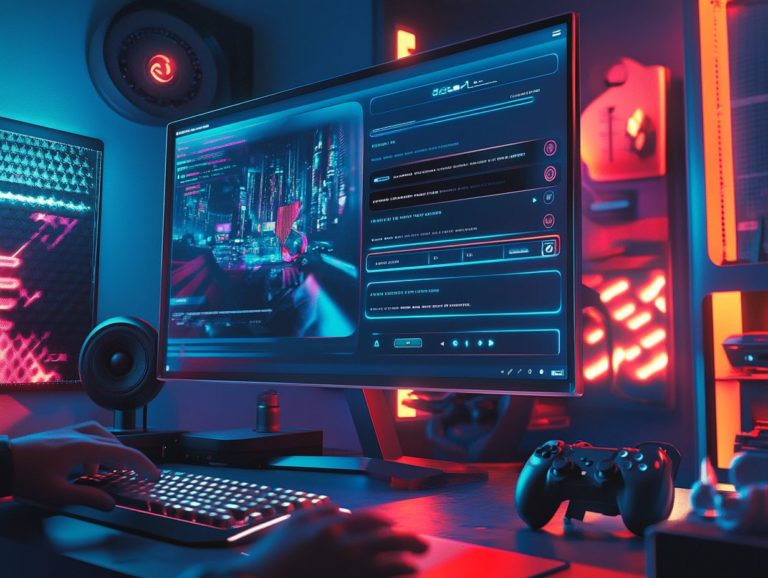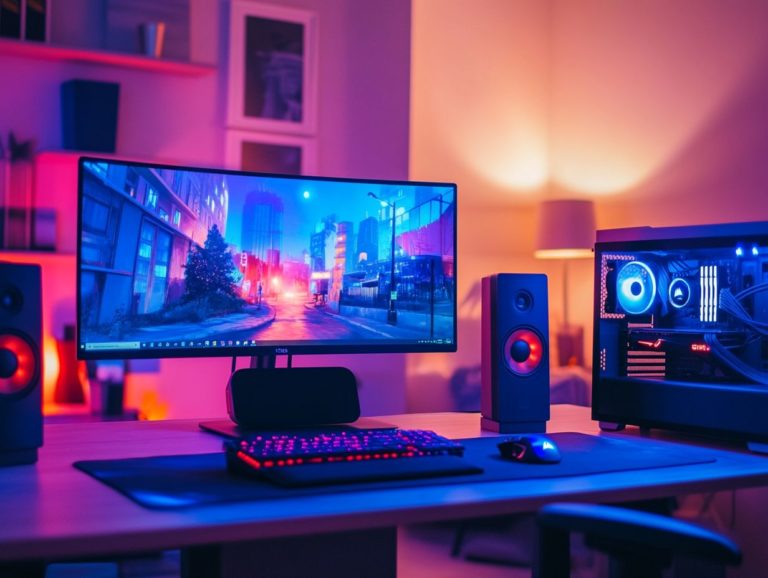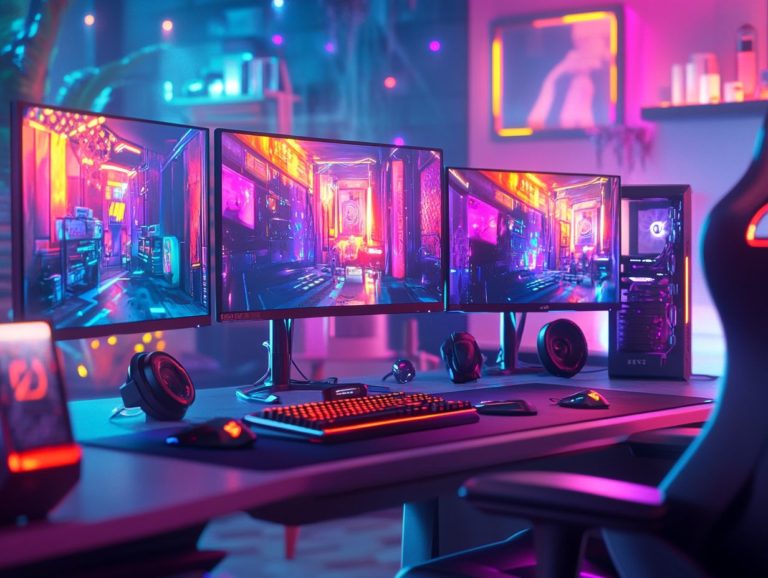the benefits of g-sync technology
G-Sync technology has really transformed the gaming experience, delivering smoother visuals and minimizing image break-up.
By synchronizing your monitor’s refresh rate with your graphics card, G-Sync elevates gameplay, ensuring that every frame flows seamlessly.
This article delves into the essence of G-Sync, explaining how it operates, its benefits for gamers, compatibility requirements, alternative technologies, and any potential drawbacks.
Whether you re a casual gamer or a competitive player, grasping the nuances of G-Sync could profoundly enhance your gaming adventures.
Contents
Key Takeaways:
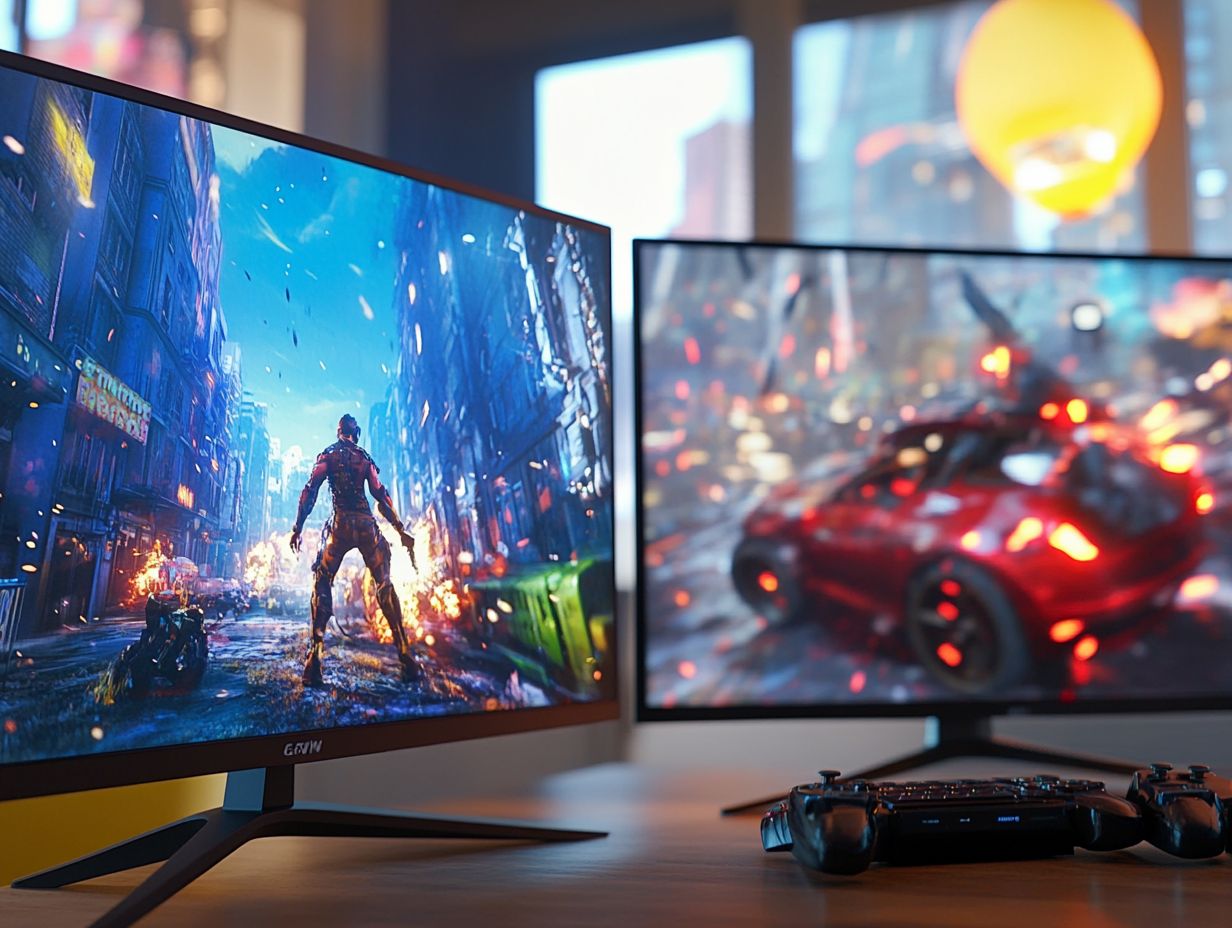
G-Sync technology enhances gaming performance by synchronizing the graphics card and monitor, resulting in smoother and more responsive gameplay. With G-Sync, gamers can enjoy reduced image break-up and delay in response, providing a more immersive and fluid gaming experience. While G-Sync has its advantages, it may come with a higher cost and limited availability. There are also alternative adaptive sync technologies and manual methods for reducing image break-up.
Understanding G-Sync Technology
G-SYNC technology, created by NVIDIA, transforms your gaming experience by synchronizing the speed at which your monitor displays new images with the frame output of your graphics card. This means you enjoy a smoother and more responsive gameplay experience.
With this cutting-edge technology, image break-up and stuttering become relics of the past, particularly in high-stakes competitive gaming situations. It also ensures lower delay in response while maintaining your monitor’s performance.
Whether you re rocking a high refresh rate display like a 144Hz or 240Hz model, G-SYNC is designed to elevate your visual experience by delivering a variable refresh rate that adapts to your frame rate in real time.
What is G-Sync and How Does it Work?
G-SYNC is a proprietary technology found in gaming monitors designed to synchronize the display’s refresh rate with the frame output from your graphics card, resulting in a fluid and tear-free gaming experience.
By dynamically adjusting the refresh rate to align perfectly with the frame rate delivered by your GPU, G-SYNC effectively tackles issues like image break-up and stuttering that can arise when these two components fall out of sync. This level of synchronization is especially advantageous during those high-octane gaming sessions, where every single frame matters.
Monitors equipped with G-SYNC, such as the ASUS ROG Swift and the Dell Alienware AW2521H, harness this technology to provide you with a smoother, more immersive experience. As a result, you can enjoy enhanced response times and superior visual fidelity, elevating your gameplay and keeping you fully engaged and competitive.
Advantages of G-Sync Technology
G-SYNC technology offers amazing benefits that can completely transform your gaming experience.
With its ability to reduce image break-up and lower delay in response, you can gain that crucial competitive edge in fast-paced scenarios. This means smoother, more responsive gameplay that allows you to fully immerse yourself in the action.
Improved Gaming Performance
One of the standout advantages of G-SYNC for you is its remarkable ability to enhance gaming performance by ensuring that your monitor s refresh rate is perfectly aligned with your graphics card s frame rate.
This synchronization significantly reduces image break-up and stuttering, delivering a smoother visual experience that s crucial for competitive gaming.
With G-SYNC technology at your disposal, you can enjoy high refresh rates like 144Hz or even 240Hz that are vital for maintaining fluid motion and quick responsiveness during intense gameplay.
Gamers using G-SYNC can see a 25-30% boost in frame rates even under demanding conditions when compared to traditional monitors.
The benefits are clear: precise timing and elevated refresh rates contribute to faster reaction times, giving you a competitive edge over your opponents.
Experience the thrill of gaming like never before with G-Sync!
Reduced Screen Tearing and Input Lag
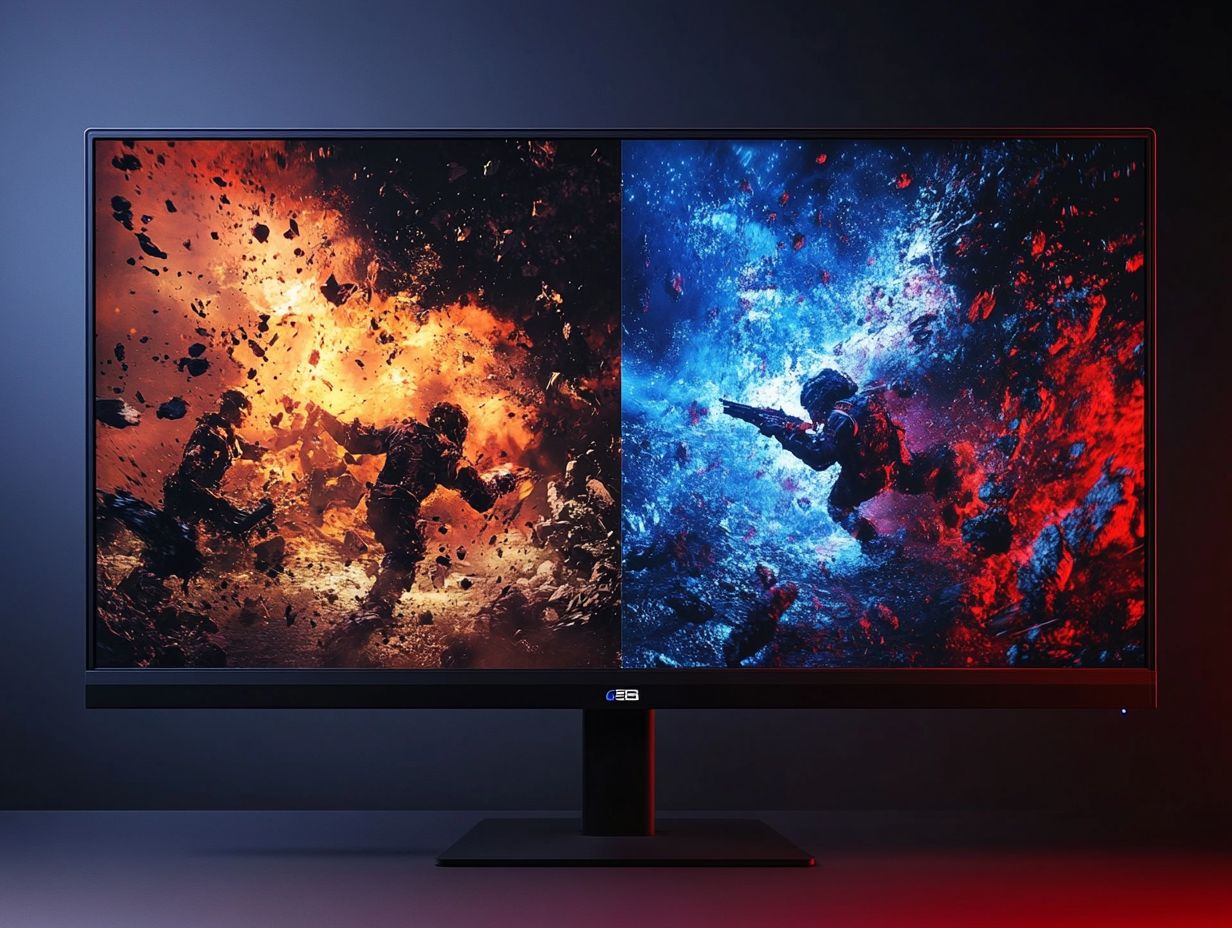
G-SYNC technology is your secret weapon against screen tearing and input lag. It creates a seamless and responsive gameplay experience that’s essential for serious gamers.
This technology adjusts screen refresh rates to match your graphics card’s output, ensuring each frame is rendered with amazing smoothness.
For competitive gamers, this precision offers a significant edge, especially in fast-paced titles like “Counter-Strike: Global Offensive” or “Overwatch.” Split-second decisions can sway the outcome of a match.
The reduced latency sharpens your reaction times and eliminates distracting visual tearing, allowing you to immerse yourself in the action.
Ultimately, G-SYNC is essential; it can transform your gaming experience into something extraordinary.
Compatibility and Requirements
Grasp the compatibility and requirements to elevate your gaming experience. You will need a G-SYNC compatible monitor, the right hardware, and suitable software configurations for optimal performance.
Compatible Hardware and Software
For a seamless G-SYNC experience, your system needs compatible hardware, including NVIDIA graphics cards and G-SYNC compatible monitors.
Utilizing NVIDIA s GeForce RTX series specifically the RTX 20 and 30 series models, along with the GTX 16 series cards ensures robust support for G-SYNC. This setup minimizes stuttering and screen tearing, resulting in smoother gameplay.
Investing in high-quality monitors like the ASUS ROG Swift, Acer Predator, or Dell Alienware series can significantly elevate your visual performance by synchronizing frame rates.
Ensure both your graphics card and monitor are G-SYNC compatible to achieve optimal performance and unparalleled immersion during gaming sessions.
System Requirements for G-SYNC
Meeting the system requirements for G-SYNC technology is essential to unlock its full potential. This ensures your gaming setup is finely tuned for stunning visual quality.
Your graphics card must be compatible, ideally from the NVIDIA GeForce lineup, with models starting from the GTX 600 series and beyond.
Your monitor also needs to support G-SYNC and have a variable refresh rate for smoother transitions and to eliminate screen tearing.
Having the latest drivers installed is equally important, as software updates can enhance performance and stability.
By adhering to these specifications, you elevate your gaming experience with fluid visuals and responsive controls.
Alternatives to G-SYNC
While G-SYNC presents substantial advantages, you have a range of alternatives to consider.
FreeSync, for instance, also employs adaptive sync technology, delivering a variable refresh rate experience on compatible monitors. This opens up exciting options for enhancing your visual experience without being limited to one solution.
Other Adaptive Sync Technologies
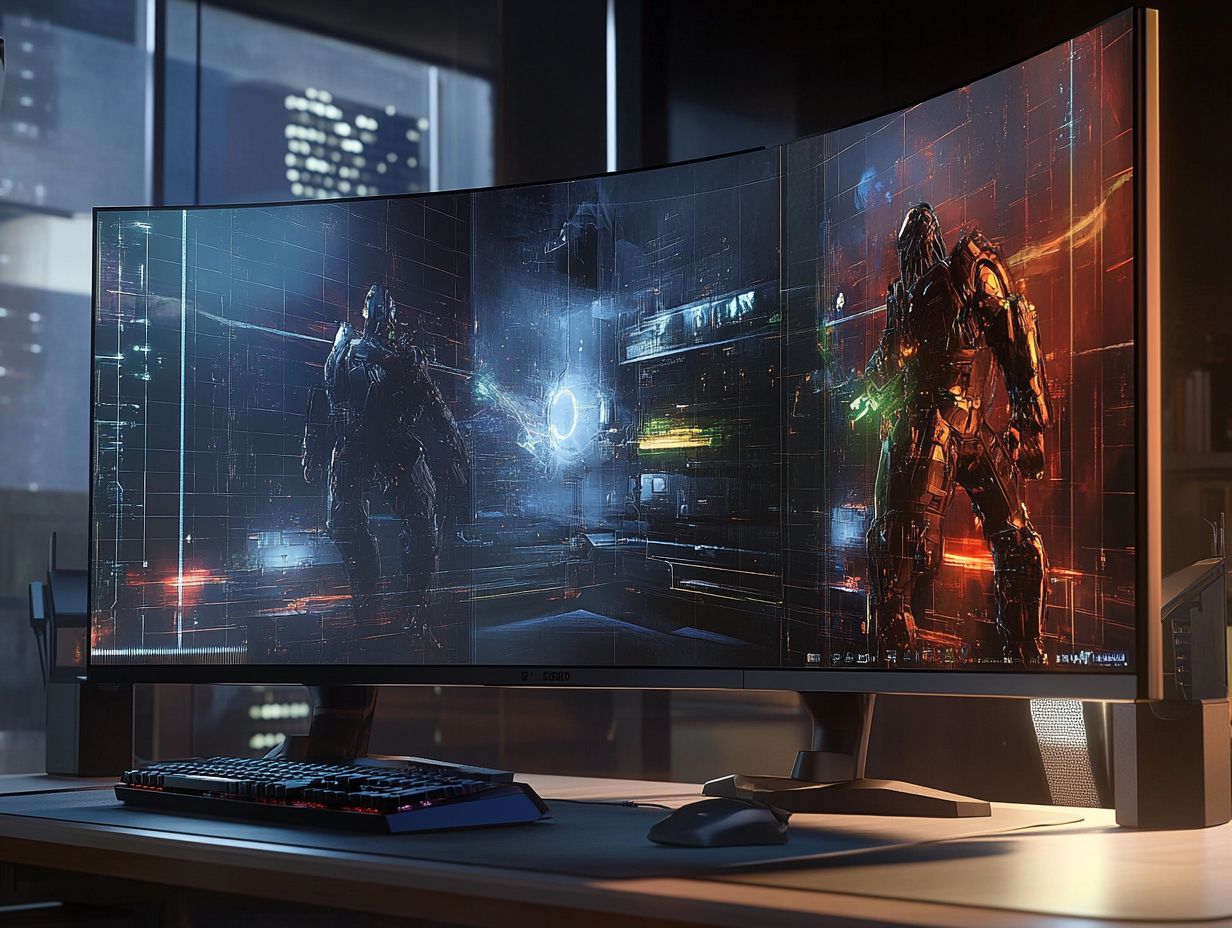
Other adaptive sync technologies, such as AMD’s FreeSync, offer benefits similar to G-SYNC, delivering variable refresh rates that enhance visual quality and reduce tearing during gameplay.
These technologies work by synchronizing the frame rate generated by your graphics card with your monitor’s refresh rate. The result? Smoother motion and a seamless gaming experience that eliminates stutter.
Take FreeSync, for example it’s highly compatible with many gaming monitors and graphics cards, especially those powered by AMD. Unlike G-SYNC, which often requires a specific hardware module within the monitor, FreeSync uses DisplayPort and HDMI standards, making it more accessible and budget-friendly for gamers!
This compatibility means you can enjoy the perks of adaptive sync without investing in premium-priced displays. This also allows more gamers to enjoy enhanced gameplay and visual fidelity.
Manual Methods for Reducing Screen Tearing
Beyond advanced technologies like G-SYNC, you have several manual techniques to reduce screen tearing. By diving into your monitor settings and optimizing game configurations, you can make a significant difference.
Examine your display settings; fine-tuning parameters like refresh rate and resolution can help align them more closely with your hardware’s capabilities. Lowering in-game graphics settings, such as texture quality or shadow detail, can dramatically boost performance and minimize tearing during intense moments.
When appropriate, enabling V-Sync (Vertical Synchronization) can help reduce screen tearing by synchronizing frame rates with your monitor’s refresh rate, paving the way for a smoother visual experience. These practical adjustments allow you to create a better gaming experience without relying solely on high-end technological solutions.
Potential Drawbacks of G-SYNC
Despite its numerous advantages, G-SYNC technology has potential drawbacks to consider.
The higher costs associated with this technology can be significant, along with the limited availability of G-SYNC Compatible monitors on the market. These aspects can influence both the price and accessibility of monitors for gamers.
Cost and Limited Availability
The cost of G-SYNC technology can present a considerable hurdle, particularly since G-SYNC Compatible monitors typically come with a higher price tag than non-G-SYNC counterparts.
This price premium can vary significantly, ranging from about 30% to even 100%, depending on the brand and specifications. For example, a standard 144Hz monitor without G-SYNC might set you back around $200 to $400, while a G-SYNC-enabled version often starts at around $500, with high-end models climbing up to $1,200 or more.
This pricing disparity can heavily influence your choices, nudging budget-conscious gamers toward more affordable alternatives. While these alternatives may lack G-SYNC, they can still deliver solid performance.
However, opting for these less expensive options might mean compromising on visual smoothness and responsiveness key elements crucial for a truly optimal gaming experience.
Compatibility with Non-G-SYNC Monitors
G-SYNC technology is tailored specifically for G-SYNC Compatible monitors, raising important questions about its compatibility with non-G-SYNC displays and how this could impact gaming performance.
If you’re using a traditional monitor without G-SYNC certification, your gaming experience may not be as smooth as you’d like. In these situations, G-SYNC functionality can be limited, often leading to frustrating screen tearing or stuttering during intense gaming moments.
You can still activate the technology, but don t expect the same level of fluidity that certified screens deliver. Also, consider potential frame rate caps and latency issues that could arise when using G-SYNC in these setups.
Ultimately, while G-SYNC can enhance your gaming experience, non-G-SYNC setups may not fully harness its benefits, potentially leaving you feeling less than satisfied.
Frequently Asked Questions
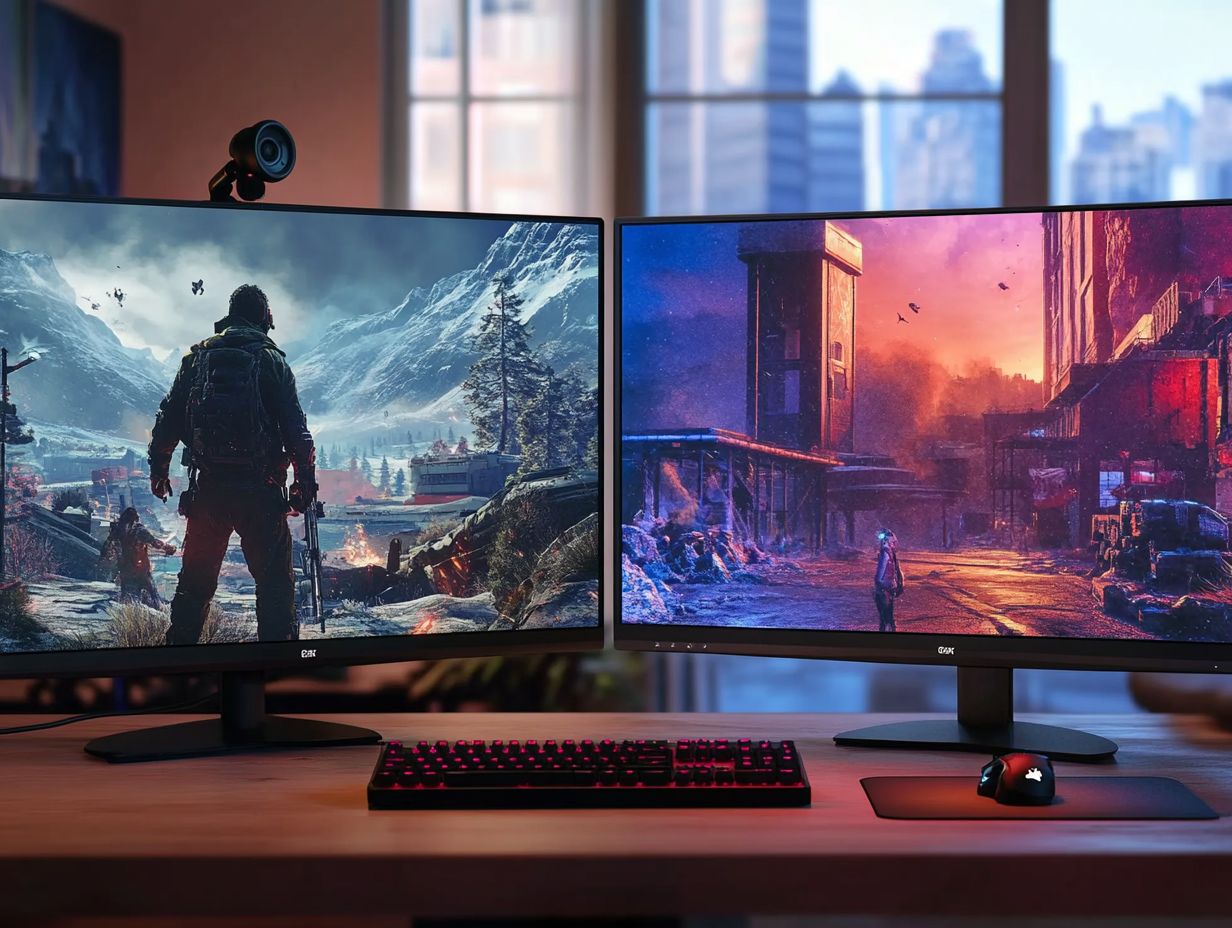
Ready to take your gaming to the next level? Explore your options today!
What is G-Sync technology?
G-Sync technology matches the refresh rate of your monitor with your graphics card. This leads to smoother gameplay and less screen tearing.
How does G-Sync technology boost gaming performance?
G-Sync eliminates screen tearing, stuttering, and input lag. This creates a more immersive and responsive gaming experience.
What are the benefits of G-Sync technology?
G-Sync provides a smoother gaming experience and better image quality.
It also reduces the load on your graphics card and CPU.
Is G-Sync only useful for gamers?
No, G-Sync also helps graphic designers and video editors.
It offers an accurate display of colors and smoother video playback.
Do all games work with G-Sync?
No, only select games support G-Sync.
However, most popular and newer games are compatible.
Can any monitor use G-Sync technology?
No, G-Sync requires specific monitors with a built-in G-Sync module.
These monitors usually cost more than standard ones.



